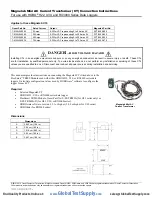
User Guide
Rev 2.0
www.semtech.com
7 of 27
TSDMTX-19V3-EVM
May-18
Semtech
No load being connected is also fine, place the receiver on the center of the transmitter target circle. Once
transmission begins, you should observe approximately 19 volts and 0 amperes on the meters.
Apply a variety of loads to observe performance at 5, 10, and 15 watt levels. Voltage should remain nearly
constant, and current should follow the P=V*I relationship. Experiment with the maximum power that can be
drawn before the receiver detects an overload and cuts off power. You should be able to observe on a minor
overload, the receiver will attempt to restore power by retesting the load intermittently. In the case of a major
overload, the transmitter may register an error, as indicated by a red LED on the transmitter, which will halt
further activity until the receiver is removed from the target area for several seconds before being placed back to
start a new transaction.
Observe Coil Signals
The following information is provided for reviewing how the EVM works in detail, as what can be observed below
is entirely managed by the Semtech TS80003 Wireless Controller. It allows the observer an opportunity to see
how the receiver and transmitter actively manage the wireless power process.
If you wish to observe the intrinsic wireless process, place an oscilloscope probe on one end of the antenna/coil,
with the probe ground connected to the board ground (one of the fastener screws will suffice). Be sure the scope
can handle signals up to 250 volts. While the EVM power supply is only 19 volts, the antenna is part of a resonant
circuit where considerably higher voltages is developed.
To observe the search ping, apply power to the transmitter and remove the receiver from the target zone. The
scope should display a ‘chirp’ of 0.5 to 1mSec in duration with an initial peak of 15 to 20 volts. The frequency
within the envelope of the chirp is in the 100-205 kHz range, which is the normal range of Qi systems.
Next, place the receiver on the transmitter target. With the scope set to 0.5 to 1 uSec and 10 to 20 volts per
division, you should observe a signal that is a composite of the sinusoidal power signal with a digital ‘notch’ in the
sinewave which is produced by the communication between the receiver and transmitter. Note as you vary the
load and the location of the receiver on the target that the amplitude and frequency of the coil signal changes.
The greater the load, the more signal is sent to transfer the power required by the load. Similarly, the less well
coupled the receiver antenna is to the transmitter coil, the more power must be sent to compensate for the
inefficient misalignment. You may note voltages near 140 volts peak-to-peak in the most demanding conditions.









































